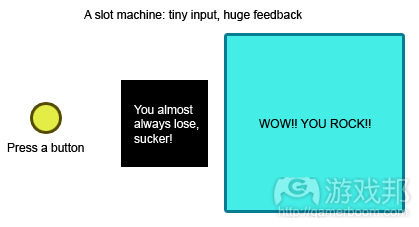叙事元素是反馈形式而非游戏机制
作者:Raph Koster
我的一大爱好就是看故事,我原先接受的是写作训练而不是游戏设计。我认为多数游戏故事并不是很精彩,我非常喜欢那些能够以引人入胜的故事情节取胜的游戏,遇到这种情况,我多半是为故事而非游戏本身所着迷。
但我的观点是:叙事元素并不是游戏机制,它只能算是一种反馈形式。
但行业中的设计师经常忽略这个简单的事实,在大众游戏市场中尤其如此。
先从游戏定义谈起。游戏可以脱离叙事元素而存在。游戏的核心在于解决问题。以游戏学观点来看,游戏是一系列问题的集合:我要到达这个位置,就得先打败敌人,就得穿越一定空间,这就要求我去摁压一个按扭。这其中有一些属于复杂问题,例如“打败敌人”,也有一些属于琐碎问题,例如“摁压按钮”。
如果你将这些操作串连起来,就会发现这些问题会在抽象问题和更简单的界面问题之间交替转换。例如,多数回合制桌游会在“下一步走到哪”这种复杂的策略问题与“拾取棋子移到这里”这类简的界面问题之间变换。桌游对界面问题的要求不会太苛刻,如果你掉了一个棋子,没有人会在意你是否会把它拾起来放回原位。
但赛车电子游戏对界面问题的要求为严格,方向盘或者虚拟摇杆的感应度很可能成为一个实实在在的驾驶挑战——其挑战性超过了该向何处指引车子这种认知性的问题。启动多数赛车游戏系统所提供的“理想路径”功能,你就会看到大部分游戏挑战来自控制系统,以及你所选车辆的黑盒运行性能。
用游戏术语的模式来看,游戏中存在一个黑盒模式,玩家的操作就是选择一些内容输入这个系统。这个系统会向玩家展示其操作行为的反馈结果。玩游戏意味着理解这个黑盒子所包含的规则。玩家主要靠直觉掌握规则,这个过程多发生于形态心理学层面而非逻辑层面。
大脑最终会将所有界面问题视为琐碎性的内容(游戏邦注:例如“点击鼠标”、“摁压按钮”)。但我们也不能忽略琐碎操作的重要性,它关系到反馈结果是否与玩家所解决的问题相匹配(例如我们点击鼠标时会听到某些声响)。反馈可让玩家知晓自己是否准确理解了黑盒子的游戏规则。所以玩家每次输入操作时,游戏都要提供相应反馈,这种反馈可引导玩家执行正确操作。
很显然,如果你移除了以下任意一种元素,都将使游戏成为一个无法运行的空壳。
*删除输入设置,游戏就只是一个屏幕保护程序。
*删除黑盒中的问题,游戏就只是一个幻灯片。
*删除反馈结果,游戏就成了一个不伦不类且难以理解的东西。
也就是说,大脑会为反馈结果感到兴奋,因为它会激活大脑中的奖励机制。它也很容易让大脑误以为自己已经获得什么成就(实际上可能一无所获)。这也是玩家很容易因黑盒系统的反馈(游戏邦注:这些系统的设计可能极为简单,甚至根本就没有向玩家传授任何有价值的内容,例如赌博)而上瘾的原因所在。我们通常将这种提供丰富反馈结果的手段称为“生动性”设计,但如果滥用这种机制吸引用户重复光顾时我们也将其称为“剥削性”设计。
游戏是一种复合型媒介。它们由许多其他媒介组成,反馈是其主要特点。换句话说,电影、写作、视觉艺术、音乐等媒介形式创造了游戏的反馈结果,独立于这些媒介而存在的游戏通常极为“抽象”——它实际上只是一种数学图表或公式,而非简单可视、可理解的内容,所以任何游戏都至少都要涉及一点其他媒介元素。
这些媒介本身都已经极为强大,并且具有各自优势。你可以使用音乐来传情达意,这种操作对音乐来说并不难。游戏系统也能传递情感,但对游戏系统来说,这绝非易事,此外游戏系统本身的情感色彩也极为有限。
所以其他媒介不仅要以辅助形式强化游戏体验,还要扮演与游戏系统平行的角色,发挥各自优势传递信息。
而最常与其保持平行关系,并且较少干扰游戏系统的媒介当属叙事内容。
以最简单的“叙事游戏”形式,例如“选择自己的冒险”(choose-your-own-adventure)这类书为例,我们可以看到它为玩家所呈现的所有问题就是“获得圆满结局”,它实际上是一棵决策树,或者说是数学概念上的定向图。所以其中的首要问题就是本质问题——如何实现美好结局,而玩家此时根本不知道具体是什么情况,也不知道自己将面临什么选择。
能够左右玩家抉择的就是反馈结果。你的第一个反馈结果来自开始游戏的选择——书中的第一页。这个概念和玩家在棋桌上最初的布局相似。然后由此开始,玩家每做一个选择,反馈机制就会使用叙事内容告诉玩家,他的决定是否正确,或者是否有助于将其引向最终目标。
现在我将以自己去年最爱的游戏《蝙蝠侠:阿甘城》为例。游戏开头有一幕场景令人印象深刻,玩家爬上教学塔顶之时,游戏会切入一个叙事场景:有个电视机在播放Joker的视频内容,他称自己已经安置了一个炸弹,你必将在此命丧黄泉。
在这个冗长的叙事内容播放完毕后,玩家总算可以开始玩一小段游戏。玩家不得不将摄像视角移向某个窗户,然后摁下A按键。如果你没有在规定时间内完成这个操作,那么你就会丧命。如果成功了,你就会看到一个华丽的视频场景:蝙蝠侠飞跃过玻璃碎片,张开像翅膀一样的披肩,俯瞰其下恢宏的纽约全景。
这个例子所显示的顺序可归纳为以下图表:大反馈结果,然后是一个小问题,然后又是一个大反馈结果。
这种模式在今天的电子游戏中极为普遍,也就是所谓的快速反应事件(QTE)。如果我们减少了反馈内容,这个“游戏系统”就会显得很低级。《战神》、《神秘海域》等游戏也呈现了这个特征,但所幸它们都在这些“电影片段”之间插入了丰富的可玩元素。
但也有一些拙劣仿制之作基本上是由这种超简单的游戏系统所组成,并采用了糟糕的反馈机制。例如《WarioWare》,它在速度和(难以理解的)反馈结果这两点上表现很不理想。
在我看来,使用叙事元素作为反馈内容并无过错。但我们要记住的是,叙事和视觉内容是成本极高的游戏开发环节,另外它们都属于可消耗内容,而系统性驱动的游戏系统却可用相对较少的规则,提供许多问题供玩家解决,让他们制造更多乐趣。正因如此,叙事元素注定成本高昂,内容短暂。
假如你开发的游戏顺序如下:
那么你最后让玩家“重玩”的内容就只剩下:
如果你不能推出更多内容,你就没法促使玩家不断玩游戏。这一点对所有基于服务的游戏(例如MMO、免费增值游戏、社交游戏等)来说都很关键。
我认为设计师应该为游戏引进丰富的系统性问题,因为这正是游戏这种媒介所应呈现的形态,也是其艺术形式的中心。
假如你的反馈内容比重超过了游戏系统,那么你该怀疑自己的设计是否出现问题。而如果这些“超重”的反馈内容是以电影形式出现,那么你制作的首先是互动电影,其次才是游戏。(本文为游戏邦/gamerboom.com编译,拒绝任何不保留版权的转载,如需转载请联系:游戏邦)
Narrative is not a game mechanic
Raph Koster
I love stories. My chief hobby is reading. I was formally trained as a writer, not as a game designer (there wasn’t really any formal training for game design I got started, but that’s another story). I think most game stories are not very good. And I quite enjoy games with narrative threads pulling me through them. When I find a game with a good story, I frequently prefer to the story to the actual game! So please keep that in mind as you read: I love story.
Narrative in a game is not a mechanic. It’s a form of a feedback.
This simple fact is frequently ignored, particularly in games aimed at the mass market.
Let’s start thinking about this by looking at what a game is. Games can and do exist without narrative. The core of a game is a problem to solve. As game grammar tells us, it’s actually typically a series of nested problems: I need to reach this location, which means I need to defeat enemies, which means I need to traverse space, which means I need to mash a button. Some of these, like “defeat enemies,” are complex problems in their own right. Some of them are trivial problems, such as “mash button.”
If you string these together, you’ll typically find that the problems will alternate between abstract problems and simpler interface problems. For example, most turn-based board games alternate between the complex strategy problem of “what move to make next” and the simple interface problem of “pick up piece and move it here.” Board games, of course, tend to be very forgiving regarding interface problems; if you drop the piece, nobody minds if you pick it up and put it where you meant.
If you take something like a racing videogame, you now have a fairly hard interface problem; the sensitivity of the steering wheel or the analog stick is now an actual physical motor challenge — often a bigger challenge than the cognitive problem of where to point your car. Just turn on the “ideal path” feature that most racing games provide and you’ll see that the challenge in the game as a whole tends to come from the dynamics of the controls and the black box of the performance characteristics of the car you have chosen.
In a game grammar model, you always have a black box model, and you select something to input into the system. The system is going to give you feedback as to what effect resulted from your action. The game is in figuring out what the rules are for the black box. Not in a rigorous way, mind you — you tend to arrive instead at a mental model that gives you a heuristic as to how to approach the black box. Your learning is generally more intuitive — or even motor memory. It tends to function less at the logical level and more at the gestalt level (cf fluid versus crystallized intelligence).
The brain therefore tends to eventually dismiss whole classes of interface problems as trivial. “Click mouse” is one of these. “Mash button.” Any black box which gets a heuristic of “guaranteed result” is going to make for a non-game very quickly.
Ah, but the feedback for even a trivial action is very important. It matters that we hear the sound when we click the mouse. And should the designer choose, they can make the feedback be hugely disproportionate to the problem solved. Feedback serves the purpose of cueing the user whether or not they are being successful in figuring out the black box. So we provide feedback each time an input is made, and the feedback is intended to help guide the user as to whether they are doing the right thing.
It is easy to see that if you remove any one of these things, you end up without a functioning game.
•Cut the input, and you have a screensaver.
•Cut the problem inside the black box, and you have a slideshow.
•Cut the feedback, and you have something ridiculously confusing that no one will tolerate.
That said, the brain happens to loooove feedback. It triggers reward mechanisms in the brain. It is remarkably easy to trick the brain into thinking that it has accomplished something when it really has not. This can result in the player getting hooked on the feedback for a black box system that is actually remarkably simple — or even designed to not teach the player anything at all, as in gambling. In design, we often terms designs “juicy” when they provide plenty of rich feedback, but we sometimes call them “exploitative” when they simply abuse feedback to keep someone going.
Games are a compound medium. They are made up of multiple other media, typically in the feedback. In other words, we rely on media such as film, writing, visual arts, music, and so on in order to provide the feedback. Games that do not rely on these other media much tend to get called “abstract” — a completely stripped bare game is actually a mathematical diagram or formula, not something easily seen or comprehended, so all games have to make use of other media at least a little.
But these other media are of course very powerful in their own right, and each have their strengths. You can use music to convey emotion using elementary musical techniques. For music it’s easy. Game systems can convey emotion as well, but for game systems it’s hard, and near as we can tell, game systems also have a very limited emotional palette. So we not only use these other media to supplement the overall experience, but these other media can convey information that exists in complete parallel to the game system.
The commonest use of a completely parallel medium that does not actually interact with the game system is narrative.
If we take the simplest form of “narrative game,” the choose-your-own-adventure type of books, what we see is that the overall problem presented to the player, “get to a good ending,” is fundamentally a decision tree, or directed graph in mathematical parlance. (Check out this link for a great giant diagram of one). So the initial problem is actually a decently substantial one — how do you get to a good ending, given that you have no picture whatsoever of the graph as a whole or even of what lies “behind the choice of doors”? Every page flip is a Lady or the Tiger sort of scenario.
What ends up influencing your choices is the feedback. Your first feedback comes from choosing to play at all: the first pages. This is exactly the same as giving you the starting layout of the pieces on a chessboard. From then on, each time you make a choice, narrative is used as the feedback mechanism to tell you whether a given choice makes sense or not in terms of leading you to your ultimate goal.
A bad example of these books would give you positive feedback all the way until it dumped you into a lava pit or other horrible doom. A good example would ensure that there was a rising action and feedback arc for each of the possible paths, leading to both a learning experience and a good story.
Side note: my favorite of these was actually one where you were trapped in a spaceship with nasty aliens, Inside UFO 54-40. There was no path to the exit. You had to actually traverse the entire graph to realize this, and then when you got suspicious, identify the page that had no inbound link to it — which then boldly celebrated your cleverness. The player’s lesson learned is therefore quite profound: sometimes situations are set up not to be winnable, don’t blindly obey the rules, and you should engage in lateral thinking when your survival is at stake.
Now I will pick on one of my absolute favorite games of the last year, Batman: Arkham City. There is a moment quite close to the beginning that has you climbing up a tower (spatial navigation puzzle with interface problems as well) only to reach the top of a cathedral where you are interrupted by a narrative moment: a video of the Joker playing on a television set, explaining that he has planted a bomb and you are about to die.
AFter this long bit of rich narrative, you are presented with a very very small game. You have to rotate your camera to point at a window, and press the A button. If you do not do it within the time allotted, you die. If you succeed, you are treated to a gorgeous cinematic moment of leaping through shards of shattering glass and spreading your cape to a rigid wing, as you float away from a savagely exploding edifice in the midst of the brooding panorama view of Gotham.
The diagram for this looks like a big pile of feedback followed by a tiny tiny problem, followed by another big pile of feedback.
This is a very common pattern in videogames these days. It even has a name: the quick time event. The black box is miniscule and simplistic. If we were to reduce the feedback, this “game system” would strike us as stupid. And it was stupidly simple in God of War, it was stupidly simple in Uncharted, etc. (Please note, I am naming some of my favorite games, made by colleagues and friends! Fortunately they, and Arkham City, offer plenty of rich systemic gameplay in between the movie bits. ) It is almost, but not quite, as stupidly simple as the page flip in a Choose Your Own Adventure book.
In fact, there was a quasi-parody series of games that basically took these sorts of super-simple game systems, and packaged them up with ridiculous feedback wrappers. It was called WarioWare. It derived all of its black box challenge from two factors: speed, and determining what the hell the confusing feedback meant. (The fun in the game was figuring out what stupidly simple action you were supposed to take).
There’s nothing wrong, to my mind, with using narrative as feedback. But we have to keep in mind that all that narrative and visual content is the expensive part of making the game. It is also consumable, whereas a systemically driven game system can provide many many problems to solve and heuristics to develop (and therefore fun to be had), with relatively few rules. Because of this, narrative content is destined to be expensive, short, and over.
If you have built a game where your graph looks like this
And at the end of it you leave the player with “replay” that is nothing but thisYou’re not going to get people to keep playing unless you keep releasing more content. This will matter quite a lot for any service-based game, be it MMO, F2P, social game, whatever.
I also feel fairly comfortable in labelling a game with that sort of structure as “a bad game design” even if it may be a great game experience. The bar that designers should strike for should include a rich set of systemic problems precisely because that is what the medium of games brings to the table. It’s what lies at the center of the art form.
If the systems of your game are outweighed by the feedback, you should grow suspicious. And if they are outweighed by feedback that takes the form of movies, you’re making interactive movies first and games second.(source:raphkoster)
上一篇:探讨游戏叙述和机制概念的不同定义

















































 闽公网安备35020302001549号
闽公网安备35020302001549号